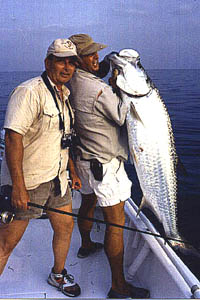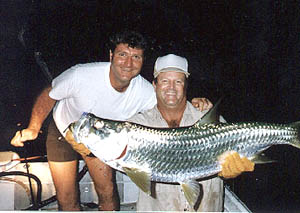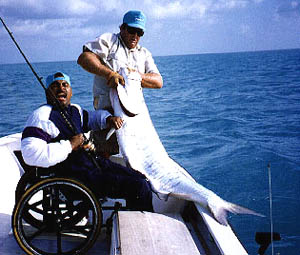 Part of the
Part of theFISHING THE FLORIDA KEYS
Series
Florida Keys Tarpon Fishing
 Part of the
Part of the
FISHING THE FLORIDA KEYS
Series
 "Silver King of the Spring"
"Silver King of the Spring"
There exists
somewhat of a debate among Florida Keys' anglers as to which fish ranks number one in
popularity. Certainly the sailfish has its share of fans, and bonefish have been
elevated to near worship status by an ever increasing number of followers. Turning to the
professional guide community won't help to clarify matters either, as the number of
devotees to snook or mutton snapper fishing only serves to cloud the issue. Yet, no
matter how dogmatic an angler or captain is on the issue of their favorite fish, few can
argue that during the spring, the tarpon is king.
The period of March and April unofficially kicks off tarpon season throughout most of the
Keys, though Key West Harbor does get a "jump start" on the rest of the island
chain by a month or so. Although tarpon are caught year 'round in the Keys (except during
the worst of the winter cold fronts), the months of April, May, and June are considered
"prime time." And as anyone who has fished for tarpon during prime time at
some of the more popular spots (Channel 2, Seven Mile Bridge, Bahia Honda Bridge and Key
West Harbor) will tell you, there are a heck of a lot of people who think fishing for the Megalops
atlanticus is really something special!
Something
for Everyone
What's the big deal about tarpon fishing anyway? After all, they aren't any good to
eat.
First, there is a size slot to fit everyone. For those who only fish light spin or
light fly, baby tarpon in the 5 to 15 pound range can be found "layed up" along
the shore of certain mangrove-lined backcountry keys. Then there is the 15 to 50
pound size slot which can be found at many of the Keys smaller and lesser-known bridges.
These fish are pure fun on the 12-15 lb. spinning tackle that a person would
normally use to catch mangrove snapper in Florida Bay or yellowtail out on the reef. And
finally, for those who want the thrill of fighting a truly large fish, the tarpon will
come through with flying (no pun intended) colors. In the Spring tarpon average
about 70 pounds, but I'm confident that I'm not going out on a limb by saying that
hundreds of tarpon in excess of 100 pounds are caught each year in the Keys during the
spring.
Regardless of their size, tarpon are known for their fighting ability. Spectacular
leaps, strong runs, and incredible endurance are all trademarks of the tarpon. And
the large ones can be really cagey in terms of tactics used to "fight" an
angler. Our Florida Keys' version of the northern whalers' "Nantucket Sleigh
Ride" takes place when we have to chase a "hot" fish through the bridge
pilings. The way many hooked tarpon weave in and out of the pilings on a high
velocity "slalom run" is truly amazing (and not for the faint of heart). I'm
convinced that at least some of these fish have been to this "prime time rodeo"
before, and have come up with their own tactics for catching and releasing springtime
tarpon anglers!
Another plus for tarpon fishing is that fishermen aren't subjected to the long, sometimes
rough rides to the fishing grounds, as is the case with many other types of fishing.
Nor are anglers at the mercy of a scorching mid-day sun, as most tarpon fishing
takes place early in the morning or else in the late afternoon/early evening hours.
Spectacular sunrises and sunsets are another bonus for anglers in search of tarpon.
Finally, the fact that tarpon are not edible works in their favor; all tarpon are
released, except those that are potential world records (and even then the required
purchase of a $50 tag from the State keeps this number at a minimum). Even if an
angler wishes to have his tarpon mounted, it's not necessary to kill the fish; it is
simply measured, photographed and released. The measurements are then sent to the
taxidermist of choice for a high-quality reproduction mount. Thus, our tarpon
fishery is a sustainable resource, and as many will attest, tarpon fishing is alive and
well in the Florida Keys!
Technique
 There are many techniques
used for targeting tarpon but the most popular is that of drift or anchor fishing with
live bait. Tackle generally consists of a matched 20 to 30 pound spinning or
conventional outfit, and typical baits include mullet, pinfish, crabs and oversized shrimp
(to name just a few). For terminal tackle, it's wise to double about six feet of
line with a bimini twist and then tie on a strong black barrel swivel. A six foot length
of 125 pound mono is tied to the swivel with a 3 turn uni knot, and then the hook of
choice is tied to the other end of the leader. I say "hook of choice"
because it's hard to find two captains that agree on the best style or size of tarpon hook
to be used. Each captain, including myself, thinks his particular style and size is
the best. According to Capt. Dave Navarro at the World Class Angler, his two best selling
tarpon hooks are the 39960 Mustad circle hook (size 13/0), and the Mustad 92671 short
shank live bait hook (size 8/0). These hooks by the way are for use with mullet, a
large live bait. If you use pinfish or any smaller bait, you'll need a corresponding
drop in hook size.
There are many techniques
used for targeting tarpon but the most popular is that of drift or anchor fishing with
live bait. Tackle generally consists of a matched 20 to 30 pound spinning or
conventional outfit, and typical baits include mullet, pinfish, crabs and oversized shrimp
(to name just a few). For terminal tackle, it's wise to double about six feet of
line with a bimini twist and then tie on a strong black barrel swivel. A six foot length
of 125 pound mono is tied to the swivel with a 3 turn uni knot, and then the hook of
choice is tied to the other end of the leader. I say "hook of choice"
because it's hard to find two captains that agree on the best style or size of tarpon hook
to be used. Each captain, including myself, thinks his particular style and size is
the best. According to Capt. Dave Navarro at the World Class Angler, his two best selling
tarpon hooks are the 39960 Mustad circle hook (size 13/0), and the Mustad 92671 short
shank live bait hook (size 8/0). These hooks by the way are for use with mullet, a
large live bait. If you use pinfish or any smaller bait, you'll need a corresponding
drop in hook size.
To finish off the rig I often attach a float on the double line. The float is not so
much a strike indicator as it is to let you know where your bait is at any given time
(left unchecked, two active mullet slung out behind the boat can make quite a macrame out
of a couple of leaders).
Most live bait tarpon fishermen do agree on one thing; the moments preceding a
strike are some of the most exciting in all of fishing. The first indicator that
things are about to heat up can be felt in the actions of the bait. Usually the live
mullet can sense the proximity of the tarpon and will start dashing about on the surface.
Quite often, as the tarpon lunges for the mullet, the bait will jump clear, which
only serves to further infuriate the tarpon. When the mullet finally meets its
demise, it is in an incredible explosion of silver scales and sea spray. The word
that best describes this display is "awesome," and many first-time anglers have
been so mesmerized by the event that all they can do is stare slack-jawed at what just
occurred before them, forgetting totally about the previously rehearsed hook-setting
procedure.
The hookup is perhaps the most critical factor in landing a tarpon, and again, many
captains differ in technique. The most common practice during a strike is to let the
tarpon pull the rod down until it is nearly pointing at him. At this point if the angler
feels the weight of the fish at the bottom of the drop, he'll strike the fish several
times to set the hook. It's usually moments later that an angler is rewarded with
his first look at the prize, as the King clears the water in a majestic,
gill-rattling jump that is one of the defining qualities of the tarpon.
Fighting
Mad
 Each
fish is different with a personality all its own. I've had tarpon head southbound
and not stop until they got to Hawk Channel, halfway to the reef. And I've had one
head north from Long Key and not stop until he was near the border of Everglades National
Park. And then, there are those aforementioned slalom runners.
Each
fish is different with a personality all its own. I've had tarpon head southbound
and not stop until they got to Hawk Channel, halfway to the reef. And I've had one
head north from Long Key and not stop until he was near the border of Everglades National
Park. And then, there are those aforementioned slalom runners.
An interesting facet of a tarpon's anatomy is its ability to gulp air and hold it in an
air bladder. This provides supplemental oxygen to the fish during times of need:
periods of low oxygen content in the water, extended periods of hard travel, and (you
guessed it) during a battle with a fisherman. That's why it's imperative for an
angler to keep maximum pressure on the fish at all times. Each time a tarpon gets a
gulp of air during the fight, it becomes somewhat more rejuvenated. Actually, a
battle with a tarpon is quite like two boxers circling each other for an advantageous
offensive position. The tarpon tries to pull straight away from the angler with the line
running over its shoulder (so to speak). The angler and captain meanwhile work in
concert together against the fish. As the captain maneuvers the boat to produce
pressure on the fish from the side, a knowledgeable angler will get the rod tip as low
(that's right, low) as possible to negate the tarpon's effort to pull down and away from
the angler. The fight may last an hour or more on a large fish, and it is one of the
most physically and tactically challenging battles an angler will ever wage with a fish.
It should be noted though, that tarpon don't have to be six footers to provide excitement.
As was mentioned earlier, there are plenty of bridges throughout the Keys that hold
a crop of smaller tarpon. Most battles with these fish last only 5 to 10 minutes, include
lots of aerial antics, and don't leave an angler totally exhausted afterwards.
The bridges are not the only places to find tarpon though. In fact before they even
show up at some of the more popular bridges, they swarm from the Gulf of Mexico into the
back country of the lower and middle Keys. Often these fish are targeted by anglers
using live mullet or pinfish, but large live shrimp are deadly in the backcountry too.
Fly fishing enthusiasts are at home here too. Quite often pods of tarpon can be seen
"layed up" on the edge of many of the backcountry flats, providing perfect
sight-casting opportunities. But the real fly fishing thrills begin in mid to late
April (or early May at the latest) when tarpon start pouring onto the oceanside flats.
It is here that they are easily spotted and cast to, as they traverse the long
white "sand runs" bordering many of the oceanside flats.
In conclusion, tarpon are the epitome of what a sport fisherman looks for in a fish. They are top-notch fighters that come in all sizes, and have been caught on just about every conceivable type of tackle. Personally, it's my favorite fish to target, both as a guide and on those few occasions when I get to play the role of angler. If you haven't yet been tarpon fishing, you owe it to yourself to challenge the Keys' King of the Spring.
![]()
 ABOUT THE AUTHOR Captain Buddy LaPointe, has
over 20 years of experience charter fishing in the Florida Keys. A cum laude
graduate of Pensacola Christian College, Captain Buddy is professional, courteous, and
dedicated to showing his clients a great time on the water! Captain LaPointe has
been featured in the Miami Herald, and on Mark Sosin's Saltwater Journal,
(seen weekly on national television). In addition, Capt. Buddy has written numerous
articles for Sport Fishing Magazine, Saltwater Sportsman, Fishing the
Florida Keys and the Florida Keys Keynoter.
ABOUT THE AUTHOR Captain Buddy LaPointe, has
over 20 years of experience charter fishing in the Florida Keys. A cum laude
graduate of Pensacola Christian College, Captain Buddy is professional, courteous, and
dedicated to showing his clients a great time on the water! Captain LaPointe has
been featured in the Miami Herald, and on Mark Sosin's Saltwater Journal,
(seen weekly on national television). In addition, Capt. Buddy has written numerous
articles for Sport Fishing Magazine, Saltwater Sportsman, Fishing the
Florida Keys and the Florida Keys Keynoter.
Site last updated 9/9/99
![]()
|
HOMEPAGE | ARTICLES | EMAIL/FEEDBACK |